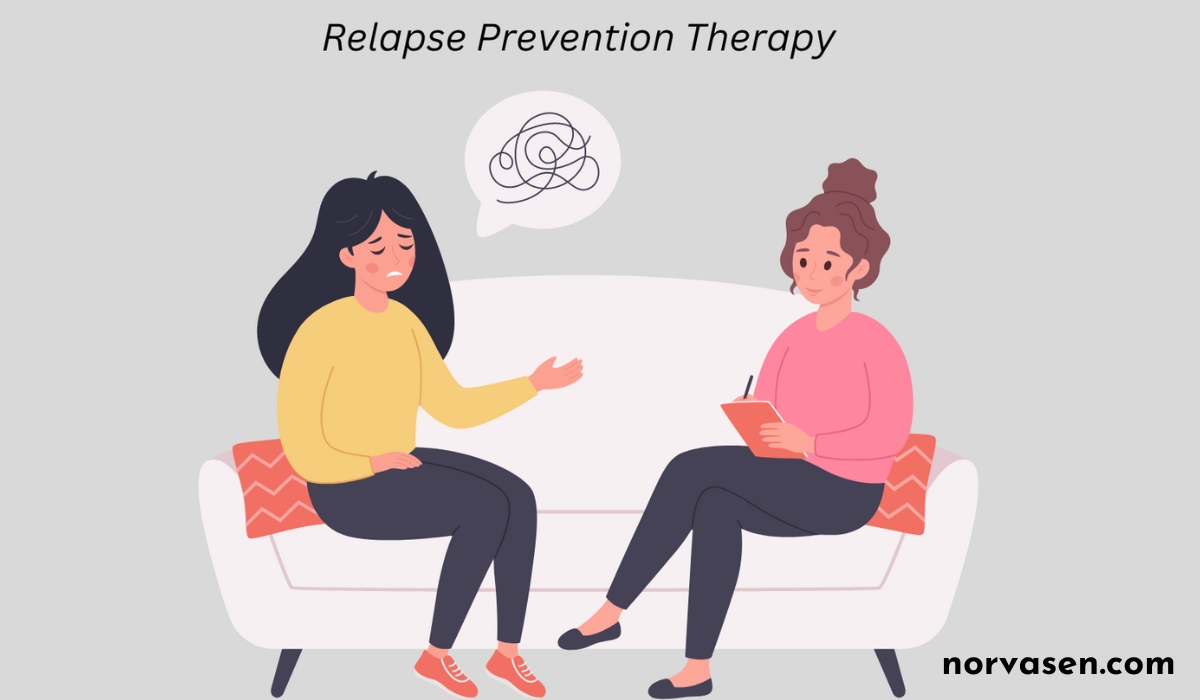Health
The Role of Motivation in Relapse Prevention Relapse Prevention Therapy: Finding Your Why

Relapse is a recurrence of addictive behaviour after an effort at recovery. It is beneficial to particularly address relapse throughout rehabilitation efforts. According to statistics, the majority of those who try to rehabilitate will relapse at some point. Without prior planning, cravings will inevitably lead to relapse. When a relapse develops, feelings of guilt and self-blame may exacerbate the problem.
It’s a beacon of hope.It helps individuals in the tough journey of addiction recovery. Evidence forms the basis of this therapeutic approach. It uses tailored interventions. It aims to stop relapse. It gives people the tools for lasting sobriety and well-being. It covers substance abuse and behavioural addictions. It offers a full framework. The framework aims to address the many aspects of relapse triggers and cravings.
This guide covered the main ideas and methods of Relapse Prevention Therapy. We’ve explored how well it works in addiction recovery. We cover the nuances of this therapy. We start with the causes of relapse. Then, we move to practical strategies for long-term success.Are you seeking guidance for yourself or a loved one? This resource is a roadmap to navigate the challenges of recovery. It will help you embrace a hopeful, strong future.
How does Relapse Prevention Therapy work?
RPT is a structured approach.
It aims to empower people to stay in long-term recovery from addiction. Cognitive-behavioural principles form the basis of RPT. It focuses on finding and fixing the factors that cause relapse. These include triggers, cravings, and negative thoughts.
At its core, RPT equips people with a range of skills.
They use these skills to handle cravings. They also use them to cope with stress and navigate risky situations. They do all this without returning to substance use or addictive behaviours. They learn to see early signs of relapse.Then, they take action to stop it.This happens through education, exercises, and therapy.
RPT also stresses the need for a strong support network.It also emphasises the need for self-care.This boosts resilience and maintains progress over time.
Relapse Prevention Therapy fosters self-awareness, empowerment, and accountability. It empowers individuals to control their recovery journey. They’ve been able to build a fulfilling life free from addiction.
Effective Techniques and Strategies in Relapse Prevention Therapy
RPT uses many techniques. They aim to empower people to stay sober and avoid relapse. We tailor the techniques to address the unique triggers, cravings, and challenges. These are what people face in recovery. Here are some key techniques and strategies commonly utilised in RPT:
- Finding Triggers: RPT helps people find the exact things that trigger their cravings. It also finds the thoughts of substance use. These triggers include people, places, emotions, and situations.
- Developing Coping Skills: People learn and practice coping skills. They use them to manage cravings and handle high-risk situations well. These skills may include stress management techniques, relaxation exercises, and its assertiveness training.
- Cognitive Restructuring: RPT focuses on challenging. It changes negative thought patterns and beliefs that lead to addiction. Through cognitive restructuring, individuals learn to develop more adaptive and positive thinking patterns.
- Lifestyle Modification is key: RPT says it’s important to make healthy lifestyle changes. These changes support long-term recovery. This may include improving nutrition, establishing regular exercise routines, and prioritising self-care activities.
- Build support networks: They should be flexible and comprise friends, family, fellow recovering cases, and medical professionals. These supportive connections give stimulants, responsibility, and assistance during gruelling times.
- Relapse Prevention Planning: It helps individuals create personalised relapse prevention plans that outline specific strategies and actions to take in the event of cravings or high- risk situations. These plans serve as roadmaps for navigating challenges and maintaining sobriety.
- Mindfulness and Meditation: Incorporating mindfulness and meditation practices into daily life can help individuals increase their self- mindfulness, manage stress, and cultivate a lesser sense of presence and acceptance.
Benefits of Relapse Prevention Therapy
It offers a multitude of benefits for individualities seeking to maintain sobriety and overcome addictive behaviours. predicated in substantiation- based practices, RPT provides a structured and holistic approach to recovery, addressing both the cerebral and behavioural aspects of dependence . Then are some crucial benefits of Relapse Prevention Therapy
Improved self Awareness: It encourages individualities to come more self- apprehensive of their triggers, cravings, and emotional countries, empowering them to fend early warning signs of relapse.
Enhanced Coping Skills: Through RPT, individuals develop a repertoire of managing skills and strategies to effectively manage cravings, stressors, and high- risk situations without resorting to substance use.
Reduced Risk of Relapse: By identifying and addressing implicit relapse triggers and implementing visionary measures, It significantly reduces the risk of relapse and promotes long- term sobriety.
Empowerment and Self- efficacy: Itfosters a sense of commission and self- efficacy by providing individualities with the tools and resources they need to take control of their recovery trip.
Healthy Lifestyle Changes: It emphasises the importance of making healthy lifestyle changes, similar as perfecting nutrition, engaging in regular exercise, and prioritising self- care activities, which contribute to overall well- being and recovery.
Stronger Support Networks: It encourages individualities to make strong support networks conforming to friends, family members, peers in recovery, and healthcare professionals, providing inestimable support, encouragement, and responsibility.
Long- Term Recovery: By equipping individualities with the skills, strategies, and support necessary for sustained sobriety, It promotes long- term recovery and helps individualities make a fulfilling life free from the grips of dependence .
Conclusion
By focusing on self- awareness, managing skills, and visionary strategies, RPT empowers individualities to manage triggers and cravings effectively. Its holistic framework not only reduces the threat of relapse but also promotes healthy lifestyle changes and strong support networks, essential for sustained sobriety. Whether you’re on your recovery journey or supporting a loved one, It provides the resources and guidance demanded to navigate challenges and make a fulfilling, dependence -free life.
Health
The Role of Pharmacogenetics in Addiction Treatment

Pharmacogenetics, the study of how genes influence an individual’s response to drugs, is emerging as a vital component in the field of addiction treatment. By understanding genetic variations, healthcare providers can tailor addiction treatments to better meet the needs of individual patients, enhancing the effectiveness of interventions and reducing adverse effects. This personalized approach promises to revolutionize addiction treatment, making it more efficient and patient-centered.
Each person’s genetic makeup can influence how they metabolize medications. Variations in genes responsible for drug-metabolizing enzymes can lead to differences in drug absorption, distribution, metabolism, and excretion.
Genetic differences can affect how a person responds to medications used in addiction treatment, such as methadone, buprenorphine, and naltrexone. Understanding these differences can help predict which medications will be most effective for a particular individual.
Personalized Treatment Plans
By analyzing genetic information, healthcare providers can select medications that are more likely to be effective and well-tolerated by the patient. This personalized approach can improve treatment outcomes and reduce trial-and-error prescribing.
Improved Efficacy and Safety
Personalized medication choices based on genetic information can enhance the efficacy of addiction treatments, leading to better management of withdrawal symptoms, cravings, and overall recovery.
Genetic testing can identify patients who are at higher risk of adverse drug reactions, allowing for the selection of safer medications. This reduces the likelihood of side effects that could hinder treatment adherence and success.
Prevention of Relapse
Understanding genetic predispositions can help identify individuals who are at higher risk of relapse. This knowledge allows for targeted interventions and more intensive monitoring, improving the chances of sustained recovery.
In addition to medication management, pharmacogenetics can inform the selection of supportive therapies, such as behavioral interventions, that are most likely to be effective for the individual.
Opioid Addiction
These medications are commonly used in the treatment of opioid use disorder. Pharmacogenetic testing can help determine which patients will respond best to methadone or buprenorphine and at what dosages.
Used for both opioid and alcohol dependence, naltrexone’s effectiveness can vary based on genetic factors. Pharmacogenetic insights can guide its use, enhancing its efficacy in preventing relapse.
Alcohol Use Disorder
These medications are used to support recovery from alcohol dependence. Genetic testing can help predict patient response and tolerance, aiding in the selection of the most suitable medication.
Similar to its use in opioid addiction, pharmacogenetics can optimize naltrexone use in treating alcohol use disorder, ensuring it is used effectively and safely.
Nicotine Addiction
These medications are used to aid smoking cessation. Genetic testing can identify which patients are likely to benefit from varenicline or bupropion, improving quit rates and reducing the risk of relapse.
Challenges and Future Directions
While pharmacogenetics holds great promise, several challenges need to be addressed to fully realize its potential in addiction treatment:
Accessibility and Cost
Pharmacogenetic testing can be expensive, limiting access for some patients. Efforts to reduce costs and increase insurance coverage are essential to make these tests more widely available.
Access to pharmacogenetic testing is often limited to certain healthcare settings. Expanding access to these tests in various healthcare environments, including primary care and addiction treatment centers, is crucial.
Clinical Integration
Healthcare providers need education and training on the use of pharmacogenetic testing in addiction treatment. Integrating these tests into clinical practice requires a solid understanding of their benefits and limitations.
Developing standardized guidelines for the use of pharmacogenetics in addiction treatment can help ensure consistent and effective application across different healthcare settings.
Ethical Considerations
Ensuring patient privacy and obtaining informed consent are critical when conducting genetic testing. Patients must be fully aware of how their genetic information will be used and protected.
Addressing potential disparities in access to pharmacogenetic testing is essential to prevent widening health inequities. Efforts must be made to ensure that all patients, regardless of socioeconomic status, can benefit from personalized addiction treatment.
Pharmacogenetics offers a promising path toward personalized addiction treatment, enhancing the efficacy and safety of interventions by tailoring them to the genetic makeup of individual patients.
Health
The Benefits of Expert ABA Therapy for Children with Developmental Needs

Introduction
Applied Behavior Analysis (ABA) therapy is a well-established and scientifically validated approach used to improve the behaviors and skills of children with autism and other developmental disorders. The effectiveness of ABA therapy Fulton County is significantly enhanced when delivered by experts who can tailor individualized treatment plans to each child’s unique needs. This personalized approach ensures that each child receives the most appropriate and effective interventions, leading to better outcomes. This article explores the benefits of expert ABA therapy, the process of creating individualized treatment plans, and the overall impact on children with developmental needs.
Understanding ABA Therapy
ABA therapy is grounded in the principles of behaviorism, which emphasize the relationship between behavior and the environment. The primary goal of ABA therapy is to increase positive behaviors and reduce negative or harmful ones by using evidence-based techniques.
The Importance of Expert ABA Therapy
Expert ABA therapy involves highly trained and experienced therapists who can effectively assess and address the unique needs of each child. The benefits of receiving expert ABA therapy are numerous and include the following:
Accurate Assessments and Diagnoses
Expert therapists are skilled at conducting thorough assessments to accurately identify a child’s developmental needs. These assessments are crucial for developing effective treatment plans and setting realistic goals.
Personalized Treatment Plans
Expert therapists create individualized treatment plans tailored to each child’s unique needs. These plans are designed to target specific behaviors and skills, ensuring that interventions are relevant and effective.
Effective Intervention Strategies
Highly trained therapists use evidence-based intervention strategies that are proven to be effective. These strategies are implemented systematically and adjusted based on the child’s progress and changing needs.
Ongoing Monitoring and Adjustments
Expert ABA therapy involves continuous monitoring and data collection to track the child’s progress. Therapists use this data to make necessary adjustments to the treatment plan, ensuring that interventions remain effective and relevant.
Collaboration with Families
Expert therapists understand the importance of involving families in the therapy process. They provide training and support to parents and caregivers, helping them to reinforce skills and manage behaviors at home.
Creating Individualized Treatment Plans
The process of creating individualized treatment plans is a critical component of expert ABA therapy. This process involves several key steps to ensure that each child’s unique needs are addressed effectively.
Comprehensive Assessments
The first step in creating an individualized treatment plan is conducting a comprehensive assessment. This assessment includes gathering detailed information about the child’s abilities, challenges, and needs.
- Initial Intake and Interviews: The assessment process begins with an initial intake, where therapists gather information from parents, caregivers, and other relevant sources. This includes understanding the child’s medical history, developmental milestones, and current behaviors.
- Direct Observation: Therapists conduct direct observations of the child in various settings, such as home, school, or clinic. This helps identify specific behaviors and environmental factors that influence them.
- Standardized Assessments: Standardized assessment tools are used to evaluate the child’s skills and abilities in areas such as communication, social interaction, and adaptive behavior. Commonly used tools include the Vineland Adaptive Behavior Scales and the Assessment of Basic Language and Learning Skills (ABLLS).
- Functional Behavior Assessment (FBA): An FBA is conducted to identify the functions of specific behaviors, such as self-injury or aggression. This involves analyzing the antecedents (triggers), behaviors, and consequences to understand the purpose of the behavior.
Setting Goals
Based on the assessment results, therapists set clear and measurable goals that are tailored to the child’s needs. These goals guide the intervention process and provide a benchmark for tracking progress.
Developing Intervention Strategies
Therapists develop specific intervention strategies that are designed to achieve the set goals. These strategies are based on evidence-based techniques and are tailored to the child’s unique needs.
Creating a Reinforcement Plan
A critical part of the treatment plan is creating a reinforcement plan. This involves identifying items, activities, or stimuli that can be used as reinforcers in therapy. Understanding the child’s preferences is crucial for motivating and engaging them in therapy.
Implementation and Monitoring
Once the treatment plan is developed, it is implemented with close monitoring and regular adjustments to ensure effectiveness.
- Therapy Sessions: Conducting therapy sessions that focus on the goals and interventions outlined in the treatment plan. Sessions can take place at home, in a clinic, or in the community.
- Data Collection and Analysis: Systematically collecting data on the child’s behavior and progress during each session. This data is analyzed to track progress and identify areas that need adjustment.
- Regular Reviews: Holding regular review meetings with parents and caregivers to discuss progress, challenges, and any necessary changes to the treatment plan.
- Adjusting Interventions: Making data-driven adjustments to interventions based on the child’s progress and changing needs. This ensures that the therapy remains relevant and effective.
The Benefits of Expert ABA Therapy
Expert ABA therapy offers numerous benefits for children with autism and other developmental disorders, as well as their families.
Improved Communication Skills
One of the primary goals of ABA therapy is to enhance communication skills. Expert therapists use techniques such as modeling, prompting, and reinforcement to teach children how to communicate effectively. Improved communication skills can significantly enhance a child’s ability to interact with others and participate in daily activities.
Enhanced Social Skills
ABA therapy focuses on teaching social skills, such as sharing, taking turns, and understanding social cues. Expert therapists use role-playing, social stories, and other techniques to help children navigate social interactions more effectively. Enhanced social skills can lead to improved relationships with peers and family members.
Increased Independence
ABA therapy emphasizes the development of self-help and daily living skills. Expert therapists teach children to perform tasks independently, such as dressing, grooming, and cooking. Increased independence can enhance a child’s confidence and ability to participate in everyday activities.
Reduction of Problematic Behaviors
Expert ABA therapy is highly effective in reducing problematic behaviors, such as aggression, self-injury, and tantrums. By identifying the underlying causes of these behaviors and implementing targeted interventions, therapists can help children develop more appropriate ways of expressing themselves and coping with challenges.
Generalization of Skills
One of the strengths of expert ABA therapy is its focus on generalization, which is the ability to apply learned skills in different settings and situations. By teaching skills in a variety of contexts, ABA therapy ensures that children can use their new abilities in real-life scenarios. Generalization of skills enhances a child’s overall functioning and adaptability.
Techniques Used in Expert ABA Therapy
Expert ABA therapists use a variety of evidence-based techniques to teach new skills and modify behavior. These techniques are tailored to the child’s needs and are implemented systematically to ensure effectiveness.
Discrete Trial Training (DTT)
Discrete Trial Training (DTT) is a structured teaching method that breaks down skills into small, manageable components. Each component is taught individually, with repeated trials and reinforcement. DTT is particularly effective for teaching basic skills, such as language, social interactions, and academic concepts.
Natural Environment Teaching (NET)
Natural Environment Teaching (NET) focuses on teaching skills in the child’s natural environment, such as home or school. This approach promotes generalization and helps children apply learned skills in real-life situations. NET emphasizes the use of natural reinforcers, such as praise and social interactions, to motivate the child.
Pivotal Response Treatment (PRT)
Pivotal Response Treatment (PRT) targets pivotal areas of a child’s development, such as motivation and self-management. By focusing on these key areas, PRT aims to produce broad improvements in behavior. PRT is child-directed and incorporates play and natural interactions to create a positive and engaging learning experience.
Task Analysis
Task analysis involves breaking down complex tasks into smaller, manageable steps. Each step is taught sequentially, allowing the child to master each component before moving on to the next. Task analysis is particularly useful for teaching self-help skills, such as dressing, grooming, and cooking.
Social Skills Training
Social skills training involves teaching children how to interact appropriately with others. This includes understanding social cues, practicing conversational skills, and developing friendships. Role-playing and social stories are common techniques used in social skills training.
Communication Skills Training
Improving communication skills is a central goal of ABA therapy. Techniques such as picture exchange communication systems (PECS), sign language, and augmentative and alternative communication (AAC) devices are used to enhance verbal and non-verbal communication.
Behavior Management Strategies
ABA therapy includes strategies for managing challenging behaviors. This involves identifying the function of behaviors, developing behavior intervention plans, and using reinforcement and consequence techniques to encourage positive behavior change.
Conclusion
Expert ABA therapy offers numerous benefits for children with autism and other developmental disorders. By providing individualized treatment plans tailored to each child’s unique needs, expert therapists can effectively address specific challenges and promote skill development. The process of creating and implementing personalized treatment plans, combined with the use of evidence-based techniques, ensures that ABA therapy is both effective and meaningful. Through dedication, collaboration, and a commitment to continuous improvement, expert ABA therapy helps children achieve their full potential and lead fulfilling lives.
Health
Benzoyl Peroxide vs Salicylic Acid[1] – Which is Best for Acne

In the field of acne control, there’s much debate in comparing benzoyl peroxide vs salicylic acid[3] . It’s a long-running topic of conversation relating to a problem that affects millions of people across the world, and it’s one that we examine for ourselves here.
Look at reviews online, and you’ll find that people have success with both when fighting persistent breakouts. Of course, the truth is they’re both effective, but which is right for your skin and your needs?
To answer those questions and more, stay tuned as we explain how each option works and the reasons for choosing one over the other.
Benzoyl Peroxide vs Salicylic Acid[4] – Separating the Two
In order to separate benzoyl peroxide (BP) from salicylic acid, we need to provide some clarity as to how each one does its job. So, let’s try to settle the benzoyl peroxide vs salicylic acid[5] debate once and for all! We start by looking at BP products.
Benzoyl Peroxide – The Bacteria Buster!
So, BP washes contain a powerful microbial agent that’s really good at killing the bacteria that causes acne – Propionibacterium acnes or P. acnes for short! It’s also good at unclogging pores and removing dead skin cells and excess oil.
It’s particularly effective at dealing with inflammatory acne, which includes cysts, papules and pustules. When using antibiotics for this kind of acne, it can lead to antibiotic resistance, which means they’re not a sustainable option. However, you can use benzoyl peroxide for as long as you need to.
BP is relatively fast-acting (results usually come in 6 to 8 weeks), too, but you do need to brace yourself for a little irritation and redness. Rather than being a bad sign, this outcome actually indicates you’re doing the right thing. It’s just a matter of ensuring that it’s kept to a minimum by choosing the right strength.
Salicylic Acid – the Pore Clearer
Now we look at salicylic acid, which is a BHA (beta-hydroxy acid) that’s able to penetrate deeply into your pores, dissolving dead skin, oil and dirt in the process. It, too, has anti-inflammatory properties, but it differs from benzoyl peroxide in that it provides more of an exfoliating action that makes it more suitable for non-inflammatory acne, i.e. blackheads and whiteheads.
It’s also gentler on the skin than BP washes, so if you have sensitive skin, it might be the better option. However, because it is a little less impactful than benzoyl peroxide, it can take a little longer to treat more severe types of acne.
The Benzoyl Peroxide vs Salicylic Acid[6] Debate is a Dead Heat!
While we’d like to be able to give you a clear winner in this debate, the truth is that it’s not really a direct competition between the two. You see, the right choice depends on you. If you have inflammatory acne (the more severe kind), you’re likely to be better served by benzoyl peroxide.
However, if you’ve got blackheads or whiteheads to deal with, then salicylic acid could be the right choice. It’s a real horses-for-courses kind of situation, so you need to take a look at what you’re experiencing, and that should inform your decision.
So, there you have it – there is no one-size-fits-all best option for anyone. We hope reading our blog equips you to make the right choice and get the clear, pimple-free skin you deserve with minimal hassle.
Keyword
Keyword
Keyword
Keyword
Keyword
Keyword
-

 Tech5 months ago
Tech5 months agoExploring the Features of Innocams: The Future of Security
-

 Home Improvement3 months ago
Home Improvement3 months agoEco-Friendly Round Rug Options for Sustainable Living in NZ
-

 How-To Guides2 months ago
How-To Guides2 months agoComprehensive Guide to Cockwarming: Enhancing Intimacy and Connection
-

 Fashion3 months ago
Fashion3 months agoBlack Magic: The Elegance and Sophistication of Ultimate Homecoming Dresses in Black
-

 Apps and Games3 months ago
Apps and Games3 months agoDiscover Tickzoo: The Ultimate Platform for Video Content Lovers and Creators
-

 Business5 months ago
Business5 months agoUnlock Potential: Explore Pikruos Services
-

 Blog3 weeks ago
Blog3 weeks agoPossiblyethereal: Exploring the Ethereal Unveiling Abstract Ideas
-

 Entertainment4 months ago
Entertainment4 months agoDiving into the Audio-Visual Experience with AV Tub: Innovating Our World of Media
















